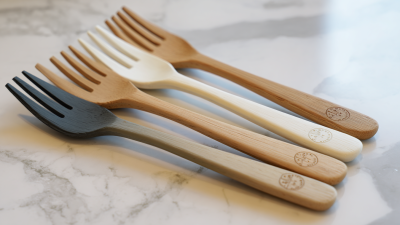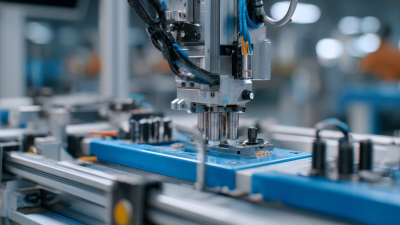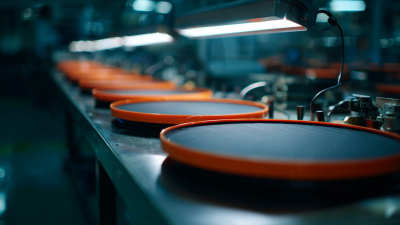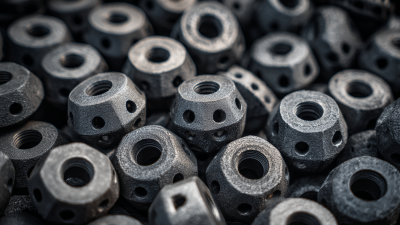How to Choose the Right Alumina Ceramic Roller for Your Industrial Needs
Table of Contents
- Understanding the Different Types of Alumina Ceramic Rollers Available
- Key Factors to Consider When Selecting Alumina Ceramic Rollers for Industry
- Benefits of Using Alumina Ceramic Rollers in Industrial Applications
- Tips for Ensuring Optimal Performance and Longevity of Ceramic Rollers
- Common Mistakes to Avoid When Choosing Alumina Ceramic Rollers
- FAQS
- Conclusion
- Related Posts
In the realm of precision ceramics, Alumina Ceramic Rollers play a pivotal role across various industrial applications due to their exceptional strength, durability, and thermal resistance. According to a recent market research report, the alumina ceramics market is projected to grow at a CAGR of 5.3% from 2021 to 2028, highlighting the increasing demand for high-performance ceramic components. ST.CERA CO., LTD., a high-tech enterprise specializing in precision ceramic manufacturing, brings expertise in research and development, ensuring that their Alumina Ceramic Rollers meet the diverse needs of industries ranging from manufacturing to aerospace. With a dedicated team of top-ranking experts and engineers, ST.CERA CO., LTD. is positioned to deliver innovative and reliable solutions in the ever-evolving landscape of precision ceramics. Choosing the right Alumina Ceramic Roller is essential for optimizing production processes and enhancing product quality, making informed decisions critical for industry stakeholders.

Understanding the Different Types of Alumina Ceramic Rollers Available
When selecting the right alumina ceramic roller for industrial applications, understanding the variety of types available is essential. Alumina ceramic rollers are vital components in numerous manufacturing processes due to their superior hardness, chemical resistance, and thermal stability. They can be broadly categorized based on their specific applications, including high-temperature resistance rollers, rollers designed for harsh chemical environments, and those dedicated to precision operations. Each type serves distinct purposes, making it crucial to assess the specific requirements of your operation before making a choice.
At St.Cera Co., Ltd., we specialize in precision ceramic manufacturing, with a dedicated team of experts focused on developing high-quality alumina ceramic rollers. Our rollers undergo rigorous testing and are designed to meet the diverse needs of our clients across various industries. By paying attention to factors such as temperature tolerance, load capacity, and environmental exposure, businesses can ensure optimal performance and longevity of their ceramic rollers, ultimately enhancing operational efficiency and product quality.
Key Factors to Consider When Selecting Alumina Ceramic Rollers for Industry
When selecting alumina ceramic rollers for industrial applications, certain key factors must be meticulously considered to ensure optimal performance and longevity. One critical aspect is the hardness of the alumina ceramic, which is generally rated between 80-90 on the Mohs scale. This high level of hardness allows alumina ceramic rollers to withstand high-temperature environments and abrasive conditions, making them ideal for industries such as ceramics, glass, and metal processing. A report from the Global Ceramic Roller Market indicates that the demand for high-performance rollers has surged due to increased production efficiency and quality in these sectors, driving manufacturers to prioritize hardness and durability.

Another vital factor is the size and shape of the rollers, which can significantly influence the operational efficiency in various processes. According to recent industry analysis, the diameter of ceramic rollers typically ranges from 14 mm to 600 mm, affecting their load distribution and molding performance. Selecting the appropriate size ensures that the rollers fit harmoniously within the machinery utilized in production lines. Additionally, properties such as thermal shock resistance and chemical stability are essential, as they dictate the roller's ability to perform in challenging environments where temperature fluctuations and corrosive materials are prevalent, thereby enhancing overall production reliability and safety.
Benefits of Using Alumina Ceramic Rollers in Industrial Applications
Alumina ceramic rollers have become increasingly popular in various industrial applications due to their unique properties and benefits. One of the key advantages of using these rollers is their exceptional wear resistance. Manufactured from high-purity alumina, they can withstand significant wear and tear, making them ideal for processes like grinding and material handling, where abrasiveness is a concern. This durability not only extends the lifespan of the rollers but also reduces maintenance costs, ensuring smoother operations.
Another benefit of alumina ceramic rollers lies in their ability to withstand high temperatures. In industries such as ceramics, glass, and metal, where processes often involve extreme heat, these rollers maintain their structural integrity and performance. This thermal stability minimizes the risk of deformation or failure during manufacturing, leading to increased efficiency and productivity. Additionally, their chemical inertness makes them suitable for applications where exposure to corrosive materials is a factor, allowing for a more versatile and reliable operation.
Tips for Ensuring Optimal Performance and Longevity of Ceramic Rollers
When selecting alumina ceramic rollers for industrial applications, ensuring optimal performance and longevity is crucial. Proper choice and maintenance can significantly affect operational efficiency and product quality. According to a report by the International Journal of Ceramic Engineering, the durability of alumina rollers can range from 5,000 to over 20,000 hours, depending on usage conditions and maintenance practices. Implementing the right strategies can help maximize the lifespan of these components.
One of the key tips for maintaining ceramic rollers is regular inspection, which involves checking for any signs of wear or damage. Identifying issues early can prevent costly downtime and extend the function of the rollers. Additionally, it’s essential to consider the operating temperature and load conditions; selecting rollers with the appropriate thermal resistance and mechanical strength, based on industry standards like ASTM C373, can prevent premature failure.
Moreover, proper lubrication is critical in reducing friction and heat generation during operation. Using high-quality lubricants tailored for ceramic materials can improve performance and minimize the risk of cracking or breaking. Implementing these proactive maintenance strategies ensures that alumina ceramic rollers maintain peak performance throughout their operational lifespan, aligning with industry advancements and requirements.
Common Mistakes to Avoid When Choosing Alumina Ceramic Rollers
When it comes to selecting the right alumina ceramic roller for your industrial applications, avoiding common pitfalls is crucial. One frequent mistake is neglecting to consider the specific operational conditions the rollers will face. Factors such as temperature, abrasion, and chemical exposure can significantly impact the performance and longevity of the rollers. Always ensure that the chosen roller aligns with the environmental conditions of your processes to optimize efficiency and minimize replacement costs.

Another common error is underestimating the importance of size and compatibility. Industrial setups vary widely, and an ill-fitting roller can lead to suboptimal performance and even machine damage. Take the time to measure your equipment and consult with manufacturers to confirm that the rollers chosen will not only fit but will also enhance the performance of your operations. By focusing on these aspects, you can avoid unnecessary downtime and expenses, ensuring that you make a well-informed investment in your ceramic rollers.
FAQS
: Alumina ceramic rollers are vital components in numerous manufacturing processes due to their superior hardness, chemical resistance, and thermal stability, serving a variety of industrial applications.
Selecting the right type involves assessing specific requirements related to high-temperature resistance, harsh chemical environments, and precision operations, ensuring alignment with your operational conditions.
Important maintenance factors include regular inspection for wear and damage, consideration of operating temperature and load conditions, and using appropriate lubrication to reduce friction and heat generation.
The durability of alumina ceramic rollers can range from 5,000 to over 20,000 hours, depending on usage conditions and maintenance practices.
A common mistake is neglecting to consider the specific operational conditions such as temperature, abrasion, and chemical exposure, which can significantly impact performance and longevity.
Proper size and compatibility are crucial because an ill-fitting roller can lead to suboptimal performance and potential machine damage, resulting in unnecessary downtime and expenses.
High-quality lubricants tailored specifically for ceramic materials should be used to improve performance and minimize the risk of cracking or breaking during operation.
Choosing the appropriate ceramic rollers that match environmental conditions enhances operational efficiency and product quality while minimizing replacement costs and downtime.
ASTM C373 provides industry standards for thermal resistance and mechanical strength, helping businesses choose rollers that can prevent premature failure based on operating conditions.
Maximizing lifespan involves implementing regular inspections, selecting the right rollers for the application, ensuring proper lubrication, and adhering to maintenance best practices.
Conclusion
Choosing the right Alumina Ceramic Roller for industrial applications is crucial for enhancing efficiency and performance. Understanding the various types available and considering key factors such as load capacity, temperature resistance, and surface finish can significantly impact the selection process. The benefits of using Alumina Ceramic Rollers include superior durability and reduced friction, making them ideal for high-speed operations. To ensure optimal performance and longevity, regular maintenance and careful operation are essential. Additionally, avoiding common mistakes, such as neglecting specific operational requirements or selecting inferior materials, is vital for achieving the best results.
At St.Cera Co., Ltd., we specialize in precision ceramic manufacturing and provide insights into optimizing your ceramic roller choices for various industrial needs. With a team of experts dedicated to research and development, we are committed to delivering high-quality Alumina Ceramic Rollers that cater to the specific demands of our clients.
Related Posts
-

How to Choose the Best Alumina Ceramic Fork for Your Kitchen Needs
-

Challenges Faced with Esd Ceramic Arm in Manufacturing Processes
-

The Future of ESD Ceramic Paddle Innovations and Their Impact on Global Supply Chains
-

What You Need to Know About 4'' Ceramic End Effectors: A Comprehensive Guide
-

7 Essential Tips for Sourcing the Best Silicon Carbide Bushing Globally
-

The Ultimate Guide to Optimizing Your Semiconductor Spare Parts Inventory Management
Blog Tags:

